|
By
far and away Bill Wilson of Wilson Combat fame is
best known for his work with the 1911 pistol. I suppose the
author in his modest way is also known for his unswerving
allegiance to the 1911. However--- let me clear my throat----
there are times when it is OK to have a Glock.
The Glock has good attributes including foremost reliability.
The pistol has a low bore axis, rapid trigger reset,
and a trigger action that can be learned. I prefer the
1911 for my use but the 1911 is not for everyone. Neither is the
Glock, but we are blessed with enough choices that we need not
adhere to a single pistol. I am sure Bill Wilson, like myself,
found the Glock too big to ignore. The Glock is a major force in
the market and nothing I do or say will change that.
However,
all is not Glock perfection. I am certain the Austrians are
aghast that we feel it meet to fire lead bullets in their
wonderful polygonal barrels. At least, we did before we knew
better. And handloads! The polygonal barrel of the Glock
features a form of rifling that is quite different from the
lands and grooves we are used to. Polygonal rifling actually
produces a better seal for propellant gas and may exhibit great
accuracy. However, polygonal rifling is really suited best to
jacketed bullets. When using lead bullets there is simply no
where for the lead build up to go. As a result, lead can build
up in the barrel rather than in grooves. Over time this buildup
may restrict the bore and create a dangerous condition. Also,
Glock chambers are relieved more than most to ensure feeding.
This also bulges cases to a greater degree than other designs,
although this varies from gun to gun. I have enjoyed excellent
results in loading 9mm, 10mm and .45 ACP cartridges for the
Glock. But care must be taken. The .40 in early examples bulged
cases more than say a Smith and Wesson 4006 but just the
same I managed. But I stuck with jacketed bullets. Hornady
bulk bullets including the FMJs, 124 grain FP, various
encapsulated bullets and the XTP proved good performers. But the
dual problem of lead bullet use and the accommodating chamber
lead me to custom barrels.
Wilson
Combat was not the first to introduce custom barrels for the
Glock, but they offers first class barrels worthy of the
company's reputation. These barrels feature conventional rifling
and a good custom fit. While you may order either gunsmith fit
or drop in barrels, some fitting is required with either. The
drop in barrels for the Glock are usually just that - drop in -
but occasionally you may need to carefully file the hood or
locking lugs.
The gunsmith fit barrels are predictably the most
accurate. Remember, a custom fit may also promote accuracy and
longevity. When there is less slop in the action and the parts
return to exactly the same place time after time both accuracy
and longevity are increased. I recommend Wilson Combat barrels
for this reason. Of course, the fellow who wishes to use a drop
in barrel simply to make use of lead bullet handloads and then
to carry the polygonal rifle for duty is welcome to use the
barrel as he pleases. It is the barrel not the pistol that is
modified and the pistol remains completely stock. An advantage
of the polygonal barrel is that velocity is increased to an
extent over barrels of a comparable length that are
conventionally rifled. The advantage can be significant. I have
clocked Glock barrels at 50 fps more on average than comparable
barrels with conventional rifling, but 35 fps is more
reasonable. In the .45 ACP and 10mm calibers this velocity
difference is less of a consideration as these calibers operate
more on frontal diameter and bullet weight than upon velocity.
So,
the custom barrel is a good idea all of the way around. While
the Glock and lead bullet handloads may seem counter intuitive
with the Wilson Combat barrel accuracy is excellent. I have used
a number of .45 ACP loads with bullets from Midstates Cast
Bullets with excellent results. (204 E Hanes//Wells,
Kansas 67467-- telephone 785 488 3886) After years of firing
230 grain RNL bullets for the most part I elected to take a look
at light bullet loads for the .45 ACP. Let me tell you they are
both pleasant and accurate. There is nothing wrong with a light
recoiling big bore pistol. This puts the .45 ACP in comparable
recoil to a .44-40 with cowboy loads. That is very pleasant. I
use Titegroup powder for practically all of my shooting
although certain big bore loads require Magnum powder. Titegroup
is a good powder for all of the automatic pistols. I think that
the 200 grain Midstates SWC is probably the most accurate
bullet, but the easy to load easy feeding 200 grain RNL is a
good economical choice. However, I also used the 185 grain SWC.
Once the standard for informal practice, I donít see many
shooters using this bullet today. That is a shame. This is a
good accurate bullet that offers real economy. Less lead, a bit
less money, and even less postage to ship 500 bullets! In any
case this is very inexpensive shooting.
The
Wilson Combat barrel of course will perform as well with
jacketed bullets as any other barrel. I used the 185 grain
Hornady XTP in accuracy loads and custom barrels also give good
results, especially in the Glock. Cranking the 185 grain XTP to
1150 fps in the Model 21 .45 ACP showed no excess case expansion
and excellent accuracy. Backing off to 890 fps produced a
reliable practice load with fine accuracy.
Good
accuracy isnít really possible with the bulky factory Glock
sights. Worse, the front sight tends to snag off. How many
Glocks have you seen missing the front sight? OK, old GI 1911
staked in sights also jumped the gun, but we have long cured
that problem. The Wilson Combat Nite Eyes sight gives a
good sharp sight picture. Shadows are not tapped in the sight
and the self luminous component gives the pistol a true 24 hour
capability. These sights and the custom barrel turn the pistol
into a fifty yard versus a twenty five yard pistol. But even if
the Glock is a defensive pistol to be used at five yards the
Wilson Combat sights are a must have addition.
Finally,
we come to holsters. Wilson Combat offers several excellent
holsters for the Glock. Since I was teaching a class using the
Glock 19 9mm I opted for the Glock Tactical holster. This
is a first class holster well suited to IDPA and range use. It
is a good duty holster and may be concealed under a covering
garment, especially a photographer's jacket. My example is
crafted in Sharkskin. This is not about looks or vanity.
Sharkskin is not nearly as susceptible as leather to scratches
and wear. Sharkskin repels moisture and offers a good finish
that lasts a very long time. I am not a fan of the 9mm but I
sometimes carry the Glock when teaching Glock shooters. I load
the piece with the Cor Bon 115 grain JHP that exits the
Glock barrel at 1340 fps. The Wilson Combat holster is a good
companion to the Glock 19.
A
generation ago the 1911 .45
man's second pistol was often a .38 Super or perhaps a Browning
High Power. Today, that second favorite handgun is far more
likely a Glock pistol. Its ok to own and use a Glock, and Wilson
Combat has made the Glock even more attractive by offering first
class accessories.
R.K.
Campbell
  
Got something to say about this article? Want to agree (or
disagree) with it? Click the following link to go to the GUNBlast Feedback Page.
|
|
Click pictures for a larger version.
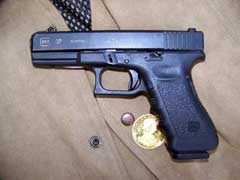
The
Glock is OK with this 1911 fan. This is the Model 37 .45 GAP.
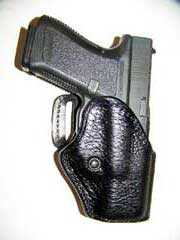
The
Wilson Combat Tactical is a fine all around holster. This
version is crafted in sharkskin
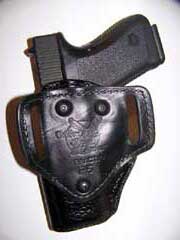
This
Tactical holster features a well designed shank with good
strong belt loops.
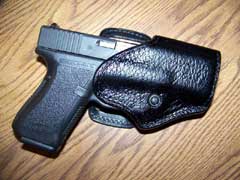
When
all is said and
done the Wilson Combat Tactical in sharkskin is not only a
striking holster but a good holster.
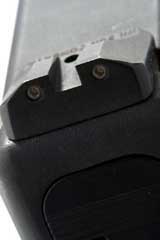
The
Wilson Combat Nite Eyes are among the most capable and
brilliant sights on the market.
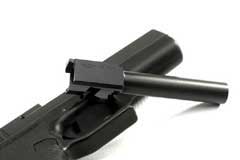
The
Wilson Combat custom barrel for the Glock is a relatively
recent innovation with an excellent reputation.
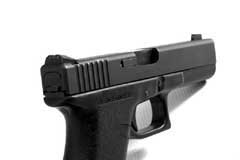
The
Wilson Combat sights really make a difference in the Glock.
You will never settle for the blocky factory sights after
using these!
|
![]()